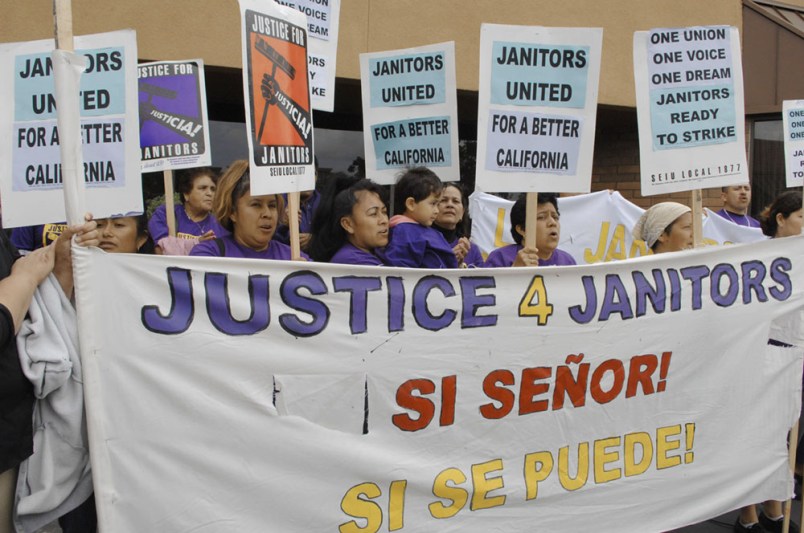This is part of TPM Cafe Book Club for Jake Rosenfeld’s What Unions No Longer Do.
One of the many things I like about Jake Rosenfeld new book, What Unions No Longer Do, is all the compelling data points he brings to bear on what used to be called with much portent, “the labor question.” Though I’ve spent a lot of time thinking about, reading, writing, and working in the labor movement, Rosenfeld’s research nevertheless told me many things I didn’t know.
Rosenfeld writes, for example, about SEIU’s Justice for Janitors (JfJ) campaign, now 25 years old, and widely—and fairly—considered the most strategically savvy and comprehensive organizing project that labor has run during that time. JfJ, as Rosenfeld writes, linked, especially in Los Angeles, a growing Latino population with parts of the labor movement determined to organize low wage workers. The campaign also buoyed the hopes of labor and its advocates because of its energy, militancy, and sheer smarts.
 Yet, as Rosenfeld notes, despite what is surely an undoubted and ongoing success, only one in seven Hispanic janitors are unionized today vs. one in five in 1988, the year Justice for Janitors began. Moreover, the percentage of all janitors, regardless of ethnicity, who are unionized, has also declined. In short, the very best run organizing campaign in years and years hasn’t been able to keep up with employment growth in its job sector, or to increase union density among the ethnic group whose cause it is most associated with championing. This isn’t SEIU’s fault — quite the contrary. SEIU had a base in building service, and wisely built on that foundation. But that hasn’t been enough.
Yet, as Rosenfeld notes, despite what is surely an undoubted and ongoing success, only one in seven Hispanic janitors are unionized today vs. one in five in 1988, the year Justice for Janitors began. Moreover, the percentage of all janitors, regardless of ethnicity, who are unionized, has also declined. In short, the very best run organizing campaign in years and years hasn’t been able to keep up with employment growth in its job sector, or to increase union density among the ethnic group whose cause it is most associated with championing. This isn’t SEIU’s fault — quite the contrary. SEIU had a base in building service, and wisely built on that foundation. But that hasn’t been enough.
JfJ also exemplified a new and welcome cosmopolitan outlook by labor. As Rosenfeld observes, the labor movement historically has often resisted and feared immigration — even though unions themselves had been built by earlier generations of immigrant workers (though labor unions have backed the Senate’s most recent attempt at immigration reform). Still, labor believed new workers could both drive down wages and, from the point of view of union leaders, undermine their leadership. In the last 15 years, however, unions, even many of the most parochial, have increasingly supported immigration reform in large part because, like SEIU, they view Mexican, Caribbean, and Central American immigrants as good organizing possibilities. Some of these workers have been toughened by political struggles in their native countries. The prospect of being fired during a US organizing drive is not enough to deter them.
But Rosenfeld argues that the “context of reception” has changed for immigrant workers. In the mid 20th century, a “rapidly growing labor movement” helped white ethnic European workers become middle class. Despite Justice for Janitors and other immigrant centered organizing programs in other low wage industries like hotel housekeeping, labor is no longer strong enough — with a couple of regional exceptions — to lift Hispanic workers into the middle class.
And the problem that should haunt labor advocates is not (just) that the context of reception did not change following the Great Recession. Bad times can cut two ways. Yes, economic collapse often generates angry workers. Just as often, however, the famous “reserved army of the unemployed” weakens worker’s resolve — it’s hard to hard to tell the boss to go to hell precisely at the moment when one is most replaceable. Even during the Depression, organizing peaked not at the worst moments, but when the economy began to turn around between 1933 and 1937. And certainly nobody needs to be reminded that massive economic instability can generate revanchist extremism as much as leftist egalitarianism.
So economic distress is no guarantee for either union growth or a corresponding political boost for it from the left. What’s perhaps even more vexing is why, during the tightest labor market in decades — the late ‘90s of 4 to 5 percent unemployment and 4 to 5 percent real GDP growth — confident workers, with no worries of a reserve army of job seekers at their backs, didn’t flock to unions either.
Like the successful, yet nevertheless wholly inadequate Justice for Janitors campaign, the inability of unions to grow during the late ‘90s boom tells us that when things are going well for unions in the modern era, they still aren’t going nearly well enough.
Rich Yeselson is a writer who lives in Washington, DC.
—
Photo: Flickr/SEIU International






